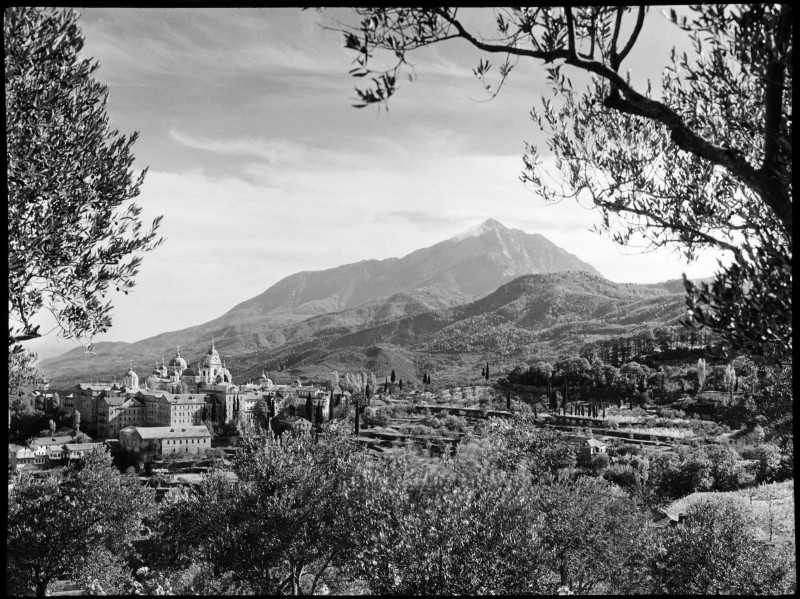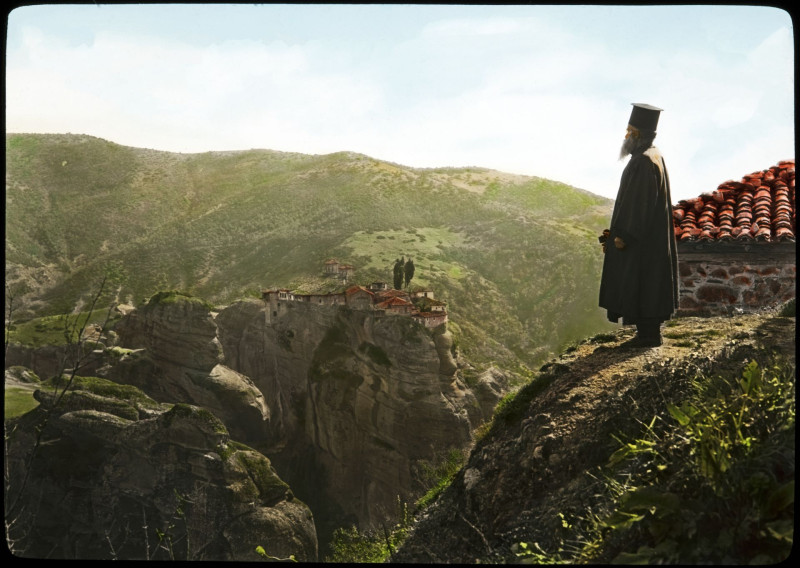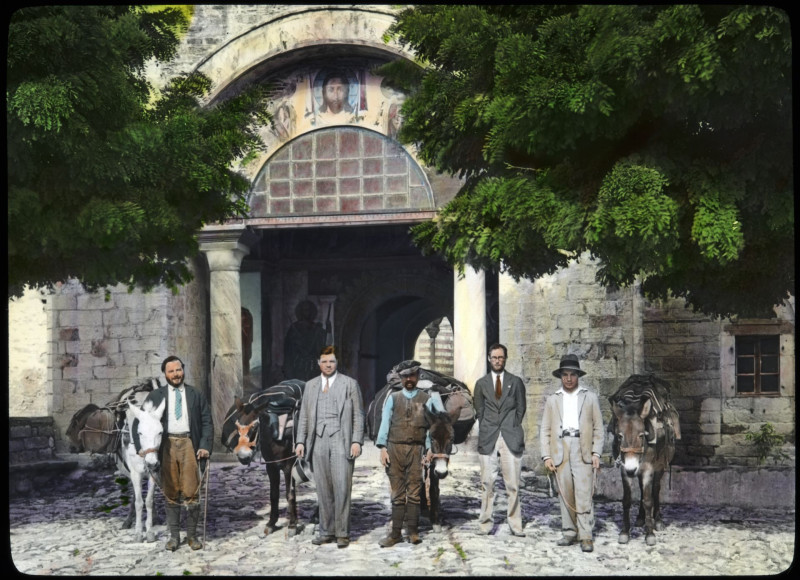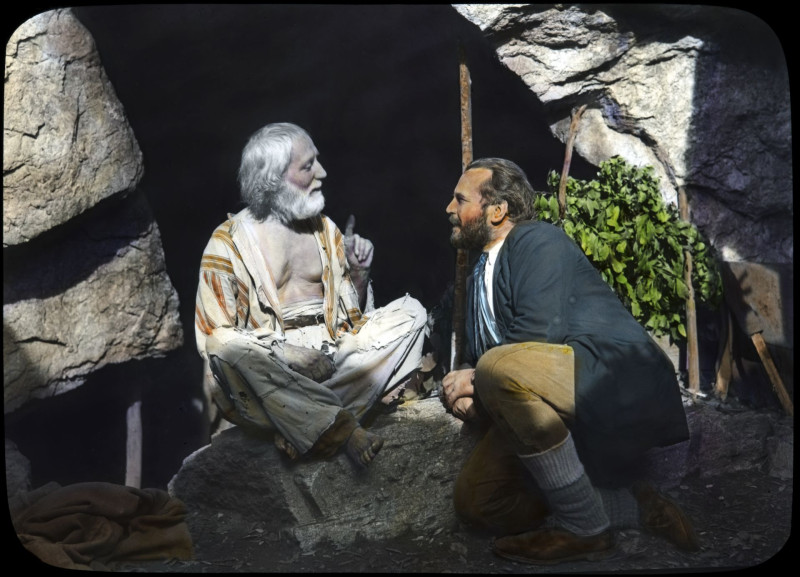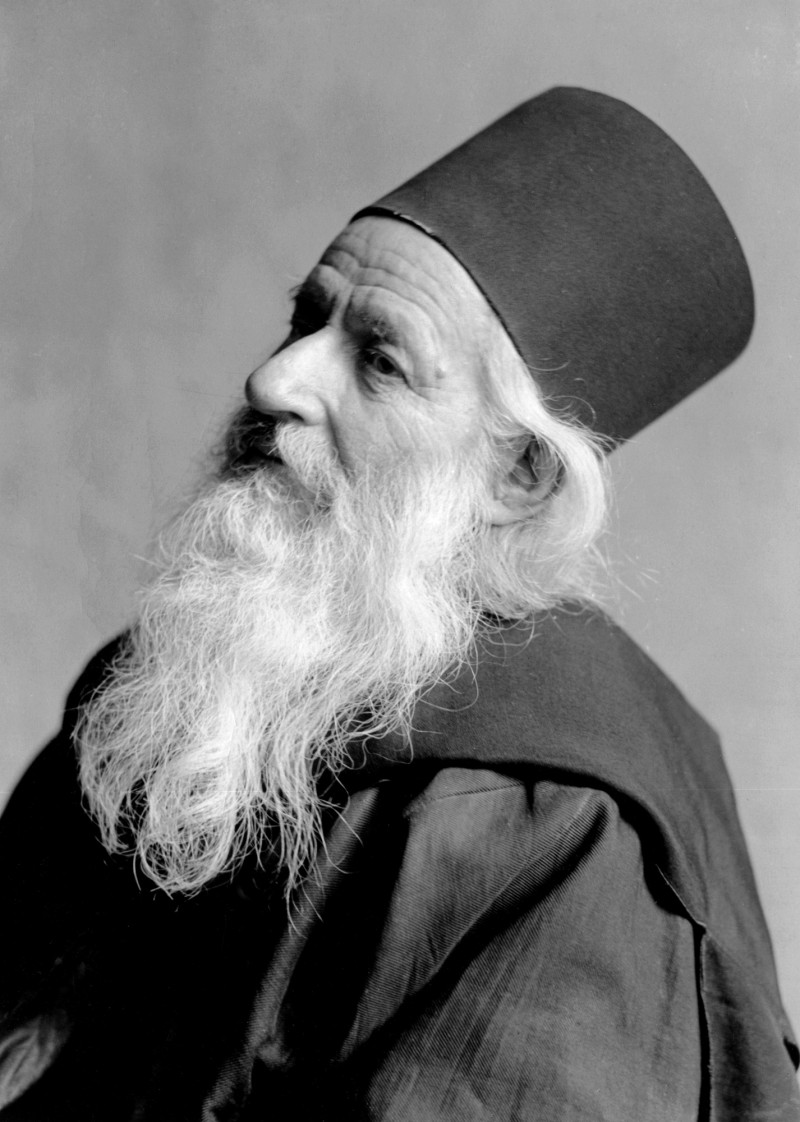The rare material of Mount Athos and Meteors was hidden for 95 years in a barrel at Princeton University – “On this man who lives in a cave and feeds on grasses and fruits, the whole legend of Mount Athos is built”
It is the year 2017, when the Department of Art and Archeology at Princeton University in the USA undergoes an internal move. Behind a bookcase is revealed a large wooden barrel that has been hidden there for years. Its unsealing is surprising to the officers of the department, since they see reels of film, the projection of which brings in the light special images of Greece, since the beginning of the last century. Behind the small group that collected this material hides an interesting story, while in a few days it will be the subject of an exhibition in Thessaloniki, entitled “No woman’s land”.
A land in which no women live was the one that piqued the curiosity of three travelers – artists, who decided in 1929 to make the transatlantic journey to our country and get to know Mount Athos and Meteora up close, everywhere until 1948 it was also off-limits to women.
Whatever they saw and experienced, they photographed and filmed it with professional means, in order to present it to their country, at a time when the world had no way to see how people live on the rest of the planet.
“This material belongs to the archive of Princeton University in America. The barrel was found there, inside which there were metal canisters with film,” Anastasios Douros, director of the Agioreitiki Hestia, where the exhibition will be hosted, tells the Athenian/Macedonian News Agency.
He himself, in 2018, was one of the recipients of an e-mail sent by Princeton to various agencies in Greece, with which they asked for help, as they found that the nine canisters of film found inside the barrel, contained the recording of a trip in parts of our country. The continuation of the research carried out by the University’s officials even connected the material of the films with 254 photographic prints and 81 glass plates (16 colored) which were already unidentifiable in the Optical Media collection of the same University.
“In the e-mail I received there were no photos, only a reference to the event. I immediately responded and answered, because I found it very interesting and started asking them questions about the material,” explains Mr. Douros. After some time – and after he managed to win their trust, they sent him two or three photos electronically, and when he realized that it was rare material from Mount Athos, he himself traveled there, in order to finally sign a cooperation agreement, which stipulated that the Holy Home will help with the documentation, an exhibition will be set up at its headquarters and a relevant catalog will be published.
Oscar award winner one of the members of the expedition
The trip to Greece was organized by the Russian émigré, painter, explorer, with special communication gifts, Vladimir “Vovo” Perfilieff. “This particular one, after fighting World War I in Russia, after October Revolution settled in America. “Because of his origin, he knew the existence of the Holy Monastery of Panteleimonos (also the so-called “Russian” monastery) and more generally of the existence of Mount Athos, and he inspired the rest to travel to a world unknown to them”, says Mr. Douros and explains that during that period in America the cinema begins to flourish as a place of entertainment and information of the world. “Of course then there was no television or anything like that, so people wanted to know about strange places where people lived so differently from themselves. Thus, the peculiarity of Mount Athos, where only men live, impresses them and they call their project “No woman’s land”, he adds.
The other members of the expedition were photographer, talented cinematographer and later (in 1931) Oscar winner Floyd Crosby, as well as Princeton University graduate architect Gordon McCormick. “McCormick was the scion of a good family, while the cinematographer of the Crosby company, knew very well the use of machines, and the results of his work have an extraordinary artistic quality,” says Mr. Douros.
The three travelers were accompanied by Anastasios Hatzimitsos, then 22 years old, who had arrived in Greece that year from Constantinople, where he had graduated from the Robertio School. The fact that he spoke very good English was the reason why they chose him as their interpreter.
The identification project offered useful information about the history of St. Terms
The members of the mission were impressed by the wonderful natural landscape, the architecture of the monasteries, the daily life of the monks, their meeting with a caveman departed monk (ascetic) and his particular living conditions, as well as the universal absence of women in the Athonian Peninsula. All this they recorded without sparing in the material they collected.
“Of the nine canisters, most were damaged. Only a small part has been saved, of which the material for Mount Athos is smaller and more from Meteora”, notes Mr. Douros, who undertook its research and identification, a particularly difficult task, since almost a hundred years later, too many things have changed.
Through this journey into the past, however, he managed to extract valuable information about the history of Mount Athos. “In one photo we see three monks who are in the synodical, that is, in the… good sitting room of the Vatopedi Monastery and we see them stepping on a carpet that says “IMB” and has the double-headed eagle and the royal crown. From the research I did, I found that this it was a carpet of several hundreds of meters, which the monks of the Holy Monastery of Vatopedi had ordered from a factory in Italy immediately after the liberation of Thessaloniki in 1912, because the king was going to visit Mount Athos and they intended to lay it from the port to the monastery. Of course, the trip was cancelled, but part of the carpet still exists today as a relic”, underlines Mr. Douros.
Other photos show the manual system of keys that correspond to different bells, the crane in the kitchen of the Zografou monastery that transports the heavy cauldrons, the shoemaking workshop in the “Russian” monastery, the iconography workshop, etc. “There is also a photo from Karyes, where the spire of Protatus can be seen. When it was taken, there were houses around the temple, which were demolished a little later (in the 1930s) in order to reveal the monument. In another photo there is a gap in the area where the building of the Holy Community of Mount Athos is now, a modern building built in the 50s”, he points out.
The departed monk Ilias
The names of the travelers, their properties and their signatures were found from the research done by Mr. Douros, in the visitors’ book at the Zografou Monastery, dated “October 30, 1929”.
“Unfortunately, there is no written testimony, such as e.g. a notebook in which to report exactly where they went and what they did. All we have is a list of the photographs, their locations, and a small annotation that McCormick made when he presented them to Princeton in 1940, but because it was made many years after their trip, it had many errors, to the point that it was not we can count on her”, says Mr. Douros.
In the exhibition it was therefore not possible to classify the material chronologically, so it was divided into sections, based on thematics. “In one section are the travelers – members of the group, who are very often photographed together with monks. This is something that made a great impression on us, because – although today it would be a given for them to pose and go out in various situations inside Mount Athos, for that period it was rare, mainly because the materials were expensive and you did not spend them easily” , he emphasizes.
In another section, all the portraits of the monks captured with emotion, realism and liveliness are displayed. Many stops were also dedicated to the daily life of the monks, where the visitor to the exhibition will see their daily habits. “Most of these images are staged, they seem to be setting them up for how they will be presented, which is confirmed by the video, where they shoot the same scenes over and over again,” says Mr. Douros. A separate part of the exhibition is the architectural impression of the monasteries, as well as their journey to Meteora.
Finally, a whole section is dedicated to their acquaintance with a… strange departed monk, Elias, which also covers much of the video they shoot. “This monk I think is the great… paper they have when they go back to America, why on this man who lives in a cave and feeds on herbs and fruits, Perfilieff builds the whole legend of Mount Athos and makes presentations in newspapers and in closed clubs”, underlines Mr. Douros.
“From the total of 288 photographs and 84 glass plates, we will show only 90 photographs in the exhibition. However, the publication of a catalog will follow, which will include all the salvaged material,” says Mr. Douros and estimates that the expedition visited – if not all, at least 80% of the monasteries, while it appears to have remained there for more than one month.
It is also certain that there are other photographs that have not survived, having been found in newspaper clippings from the 1930s, which show the work of the three travelers.
Rare photos from Athens and Thessaloniki in 1929
Two separate photos that the visitor of the exhibition will see are also from Athens and Thessaloniki. “The three of them come by boat to Piraeus and a photo of Athens with the Acropolis is preserved, while Lycabettus can also be seen in the video,” says Mr. Douros.
The next photo that will be exhibited is when they have now arrived in Thessaloniki. “We have a wonderful picture in our hands from the old beach, taken from the balcony of an ultra-luxurious hotel approximately at the height of Eleftheria Square, with the White Tower in the background, commercial sailing ships along the entire length of the beach, two steamers and the power plant that existed at the height of Makedonia Palace”, says Mr. Duros.
The opening of the exhibition of historical photographs “No Woman’s Land – From Princeton to Mount Athos and Meteora in 1929” will take place on Thursday, May 25, 2023 at 19:00 at the exhibition space of the Agioreitiki Hestia (Egnatia 109). The exhibition will remain until September 16 and will be open to the public Monday and Wednesday 09:00 – 16:00, Tuesday, Thursday and Friday 09:00 – 20:00 and Saturday: 09:00 – 14:00.
Source :Skai
I am Frederick Tuttle, who works in 247 News Agency as an author and mostly cover entertainment news. I have worked in this industry for 10 years and have gained a lot of experience. I am a very hard worker and always strive to get the best out of my work. I am also very passionate about my work and always try to keep up with the latest news and trends.


